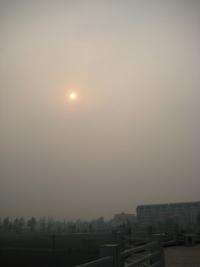A better picture of clouds

Some of us look at clouds and see animal shapes. Scientists are looking beyond. For the first time, a team of scientists led by Pacific Northwest National Laboratory used actual measurements of clouds and the atmosphere in the polluted skies over southeast China to evaluate an oft-used climate model. They wanted to see how well the model describes the effect of tiny particles from pollution on clouds, and how those clouds influence precipitation. They found that the fast, affordable cloud microphysical calculations under-predict the precipitation they know from observations and from detailed but expensive calculations.
People care about rain. More than that, they want to know how much it will rain or snow, and when and where it will fall. Scientists know that in areas of rising air pollution such as southeast China, certain clouds will produce more rain. With just enough particles from pollution, these clouds are "pushed" past fluffy to rainy. Getting an accurate computational description of these clouds and how pollution affects them is important to predict their effects on weather and climate. But, simulating these complex cloud microphysical processes takes a lot of computing power. That's why scientists turn to simple computer representations of these processes in climate modeling. The ever-present goal of climate modeling is to maximize computational efficiency at the same time gaining more realistic results. Knowing the problems with the models, scientists can make improvements to better predict how weather and climate will be changed under the pressure of increased pollution.
It's a tough challenge to simulate the complex cloud responses to increased pollution in large-scale climate models because they use simple "bulk" parameterizations, mechanisms that represent cloud microphysical processes. Detailed "bin" microphysical representations are too computationally complex for long-time and large-scale simulations. The goal of this research was to evaluate the performance of the commonly used bulk microphysical parameterization for its ability to simulate cloud properties and aerosol-cloud interactions and to identify ways to achieve a better representation.
A research team led by Dr. Jiwen Fan used observations from the Atmospheric Radiation Measurement Mobile Facility field campaigns in China in 2008 and results from detailed bin microphysics to evaluate the Weather Research and Forecasting model's ability to describe aerosol-cloud interactions in two cloud types: deep convective clouds and stratiform clouds.
For deep convective clouds, the simple bulk microphysics failed to capture important features in the observed data. In fact, it simulated the opposite aerosol effect on convection and precipitation compared with the detailed bin microphysics, which shows that precipitation is increased by aerosols. Their analysis points to an unrealistic representation of aerosols in bulk microphysics, and the much higher cloud drop number and unrealistic drop size being simulated. Many cloud microphysical processes and precipitation properties are very sensitive to the size of the droplets, so poor simulation of droplet size can lead to significant differences in aerosol-cloud interactions between simulations using bulk versus bin microphysics. For the stratiform clouds, bulk microphysics shows qualitatively consistent results compared to bin microphysics, in terms of aerosol effects. But stratiform cloud properties were poorly simulated compared to observations.
"Based on past studies, we expected aerosols to invigorate warm-based convective clouds like the case we studied in China, and precipitation would be enhanced. But bulk microphysics predicts just the opposite," said Fan, an atmospheric scientist at PNNL. "We found that the aerosol representation within the parameterizations is the main problem."
In a follow-on study, researchers will further modify the bulk microphysical parameterization to get results closer to observations and the benchmark simulations obtained using detailed bin microphysics. They will also include a third type of clouds, marine stratoculumlus, in their analysis.
More information: Fan J, et al. 2012. "Aerosol impacts on clouds and precipitation in eastern China: Results from bin and bulk microphysics," Journal of Geophysical Research, 117, D00K36, DOI:10.1029/2011JD016537.
Journal information: Journal of Geophysical Research
Provided by Pacific Northwest National Laboratory




















